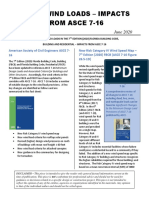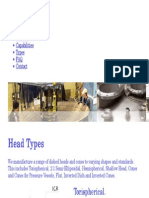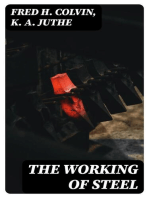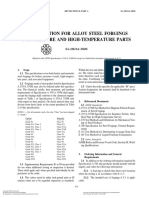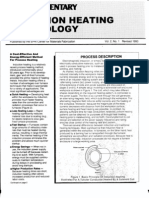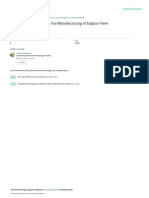Sa 266
Sa 266
Uploaded by
Alejo ZabalaCopyright:
Available Formats
Sa 266
Sa 266
Uploaded by
Alejo ZabalaOriginal Title
Copyright
Available Formats
Share this document
Did you find this document useful?
Is this content inappropriate?
Copyright:
Available Formats
Sa 266
Sa 266
Uploaded by
Alejo ZabalaCopyright:
Available Formats
2010 SECTION II, PART A
SA-266/SA-266M
SPECIFICATION FOR CARBON STEEL FORGINGS FOR
PRESSURE VESSEL COMPONENTS
~~"E
!;ETTING THE SrANDAAD
SA-266/SA-266M
[Identical with ASTM Specification A 266/ A 266M-03a(R08)]
cO
INnRNAT/ONAL
Standards Worldwld9
1. Scope 1.1 This specification covers four grades of carbon steel forgings for boilers, pressure vessels, and associated equipment.
NOTE 1 Designations have been changed as follows: Current Grade Grade Grade Grade 1 2 3 4 Formerly Class Class Class Class 1 2 3 4
E 165 Test Method for Liquid Penetrant Examination E 381 Method of Macroetch Testing Steel Bars, Billets, Blooms, and Forgings
2.2 Other Standard: ASME Boiler and Pressure Vessel Code, Section IX, Weld ing Qualifications
1.2 Supplementary requirements are provided for use when additional testing or inspection is desired. These shall apply only when specified individually by the purchaser in the order. 1.3 The values stated in either inch-pound units or SI (metric) units are to be regarded separately as the standard. Within the text and tables, the SI units are shown in brack ets. The values stated in each system are not exact equiva lents; therefore, each system must be used independently of the other. Combining values from the two systems may result in nonconformance with the specification. 1.4 Unless the order specifies the applicable "M" speci fication designation, the material shall be fumished to the inch-pound units. 2. Referenced Documents 2.1 ASTM Standards: A 275/ A 275M Test Method for Magnetic Particle Exami nation of Steel Forgings A 370 Test Methods and Definitions for Mechanical Test ing of Steel Products A 788 Specification for Steel Forgings, General Requirements E 112 Test Methods for Determining the Average Grain Size
417
Ordering Information and General Requirements 3.1 In addition to the ordering information required by Specification A 788, the purchaser shall include with the inquiry and order a detailed drawing, sketch, or written description of the forging. 3. 3.2 Material supplied to this specification shall conform to the requirements of Specification A 788, which outlines additional ordering information, manufacturing require ments, testing and retesting methods and procedures, mark ing, certification, product analysis variations, and additional supplementary requirements. 3.3 If the requirements of this specification are in con flict with the requirements of Specification A 788, the requirements of this specification shall prevail. 3.4 For hubbed flanges and tube sheets ordered for ASME Boiler and Pressure Vessel Code application, Sup plementary Requirement S12 of Specification A 788 shall be specified in addition to Supplementary Requirement S8 of this specification.
4. Materials and Manufacture 4.1 The steel shall be made in accordance with the Melting Process Section of Specification A 788. A suffi cient discard shall be made to secure freedom from injuri ous pipe and undue segregation.
SA-266/SA-266M
2010 SECTION II, PART A
4.2 The material shall be forged as close as practical to the specified shape and size. 4.3 The finished product shall be a hot-worked forging as defined by Specification A 788.
Machining 5.1 Surfaces shall be machined as designated by the purchaser. Unmachined surfaces shall be sufficiently free of scale to permit inspection.
5.2 Machining may be performed either prior to or after heat treatment at the option of the manufacturer unless specified in accordance with Supplementary Require ment Sl.
5.
Mechanical Properties 8.1 General Requirements - Except when otherwise specified in accordance with Supplementary Requirement S2, the material shall conform to the requirements for mechanical properties prescribed in Table 2 when tested in accordance with the latest issue of Test Methods and Definitions A 370. The largest obtainable tension test speci men as specified in Test Methods and Definitions A 370 shall be used.
8.1.1 Except when otherwise specified in accordance with Supplementary Requirement S2, the longitudinal axis of the specimens shall be parallel to the direction of major working of the forging. For upset-disc forgings, the longitu dinal axis of the test specimen shall be in the tangential direction. 8.1.1.1 The longitudinal axis of the specimen shall be located midway between the parallel surfaces of the test extension if added to the periphery of disks or midway between the center and surface of solid forgings. For hollow forgings, the longitudinal axis of the specimens shall be located midway between the center and outer surfaces of the wall. When separately forged test blocks are employed as defined in 8.1.3, the tension test specimens shall be taken from a location that represents the midwall of the heaviest section of the production forgings. When speci mens are required from opposite ends, they shall be taken from the diagonal corners of an axial plane. 8.1.2 Except as specified herein, tests for acceptance shall be made after heat treatment has been completed. When the ends of the cylindrical forgings are closed in by reforging, the cylindrical forgings may be annealed, normalized, or normalized and tempered and tested prior to reforging. After reforging, the entire forging shall be reheat-treated in the same manner and at the same tempera ture range as employed when the forging was heat-treated prior to certification testing. 8.1.3 When mutually agreed upon between manufac turer and purchaser, test specimens may be machined from a specially forged block suitably worked and heat treated with the production forgings. Such a special block shall be obtained from an ingot, slab, or billet from the same heat used to make the forgings it represents. This block shall receive essentially the same type of hot working and forging reduction as the production forgings; however, a longitudinally forged bar with dimensions not less than T by T by 3T may be used to represent a ring forging. The dimension T shall be representative of the heaviest effective cross section of the forging. For quenched and tempered forgings for which tests are required at both ends by 8.2.2.3 and 8.2.2.4, separately forged test blocks are not allowed.
NOTE 3 - In using separately forged test blocks, attention is drawn to the effect of mass differences between the production forgings and the test blocks.
8.
Heat Treatment 6.1 After forging and before reheating for heat treat ment, the forgings shall be cooled in such a manner as to prevent injury and to accomplish transformation.
6.2 All forgings shall be annealed, normalized, or nor malized and tempered, but alternatively may be liquid quenched and tempered when mutually agreed upon between the manufacturer and the purchaser. When temper ing is performed, it shall be at a subcritical temperature, but no less than 1 100F [595C]. 6.3 A multiple stage austenitizing procedure may be used whereby the forging is first fully austenitized and liquid quenched, followed by reheating within the intercrit ical temperature range to partially reaustenitize, and again liquid quenched. On completion of the austenitizingl quenching cycles, tempering at a temperature between 1100F [595C] and the lower critical temperature shall follow.
NOTE 2 - Although liquid quenching from the austenitizing tempera tures is more effective in enhancing impact properties, air cooling from the austenitizing temperatures is also beneficial and may be used instead of the normalizing procedure in 6.2.
6.
7.
Chemical Composition 7.1 Heat Analysis - The heat analysis obtained from sampling in accordance with Specification A 788 shan comply with Table 1 except that the additional features of Supplementary Requirements S 11 and S 12 shall also apply as individually specified in the ordering information.
7.2 Product Analysis - The purchaser may use the product analysis provision of Specification A 788 to obtain a product analysis from a forging representing each heat or multiple heat.
418
2010 SECTION II, PART A
SA-266/SA-266M
8.2 Specific Requirements - The number and location of tests are based on forging length, weight, and heat treat ment, and shall be as prescribed below. The length and weight to be used for this purpose shall be the shipped length and weight of forgings produced individually or the aggregate shipped length and weight of all pieces cut from a multiple forging. 8.2.1 Annealed, Normalized, or Normalized and Tem pered Steel Forgings:
welders and weld procedures shall be qualified in accor dance with Section IX of the ASME Boiler and Pressure Vessel Code.
10.
Certification
8.2.1.1 For forgings weighing 5000 lb [2250 kg] or less at the time of heat treatment, one tension test shall be taken from one forging per heat in each heat-treatment charge. When heat treatment is performed in continuous type furnaces with suitable temperature controls and equipped with recording pyrometers so that complete heat treatment records are available, a tempering charge may be considered as any continuous run not exceeding an 8 h period. 8.2.1.2 For forgings and forged bars weighing over 5000 lb [2250 kg] at the time of heat treatment, one tension test shall be taken from each forging.
8.2.2 Quenched and Tempered Forgings:
10.1 In addition to the mandatory certification require ments of Specification A 788, the heat treatment cycle data shall be included.
11.
Product Marking
11.1 Each forging shall be identified in accordance with the Marking Section of Specification A 788. In addition, the forging shall be marked following the grade designation by the letter "A" for annealed, "N" for normalized, "NT" for normalized and tempered, and "s" for liquid quenched and tempered, as applicable.
12.
Keywords
8.2.2.1 For quenched and tempered forgings weighing 5000 lb [2250 kg] or less at the time of heat treatment, but not exceeding 12 ft [3.7 m] in length, one tension test shall be taken from one forging per heat in each heat-treatment charge. When heat treatment is per formed in continuous-type furnaces with suitable tempera ture controls and equipped with recording pyrometers so that complete heat-treatment records are available, a tem pering charge may be considered as any continuous run not exceeding an 8-h period. 8.2.2.2 For quenched and tempered forgings and forged bars weighing over 5000 lb [2250 kg] to 10 000 lb [4500 kg] at the time of heat treatment, but not exceeding 12 ft [3.7 m] in length, one tension test shall be taken from each forging. 8.2.2.3 For quenched and tempered forgings and forged bars that exceed 12 ft [3.7 m] in length, one tension test shall be taken from each end of each forging. 8.2.2.4 For quenched and tempered forgings and forged bars weighing more than 10 000 lb [4500 kg] at the time of heat treatment, two tension test specimens shall be taken from each forging. These shall be offset 180 0 from each other except that if the length of the forging, excluding test prolongations, exceeds 12 ft [3.7 m], then one specimen shall be taken from each end of the forging. Repair Welding 9.1 Repair welding of forgings is permissible only at the option of the purchaser. If repair welding is performed,
419
12.1 pressure vessel service; steel forgings--carbon
TABLE 1
CHEMICAL REQUIREMENTS
Compositioll, % Grades 1 and 2 Carbon, max Manganese Phosphorus, max Sulfur, max Silicon 0.30 0040-1.05 0.025 0.025 0.15-0.35 Grade
Grade 4 0.30 0.80-1.35 0.025 0.025 0.15-0.35
0.35 0.80-1.35 0.025 0.025 0.15-0.35
TABLE 2
TENSILE REQUIREMENTS
Grades Grade 1 Tensile strength, min, ksi [MPaJ Yield strength (0.2% offset), min, ksi [MPaJ Elongation in 2 in. or 50 mm, min,% Reduction of area, min, % 60-85 [415-585J 30 [205J 23 38
2 and 4
70-95 [485-655J 36 [250J 20 33
Grade 3 75-100 [515-690J 37.5 [260J 19 30
9.
SA266/SA266M
2010 SECTION II, PART A
SUPPLEMENTARY REQUIREMENTS
One or more of the following supplementary requirements shall apply only when specified by the purchaser in the inquiry, contract, or order. Details of these supplementary require ments shall be agreed upon between the manufacturer and the purchaser.
S1.
Rough Turning and Boring S1.1 The position of the rough turning and boring in the sequence of manufacturing operations shall be as specified by the purchaser.
S7.
Product Analysis
S2.
Alternative Tension Test Orientation S2.1 In lieu of the requirements of Section 8, the longitudinal axis of the test specimens shall be transverse to the direction of major working of the forging. The results shall conform with requirements of Table 2, with the excep tion of the ductility limits that shall be as follows:
Grade 2 and 4 20 30
S7.1 A product analysis in accordance with Section 7 shall be made from one randomly selected forging repre senting each size and shape of forging on the order. If the analysis fails to comply, each forging shall be checked or the lot rejected. All results shall be reported to the purchaser.
S8.
Specimen Location on Forged Hubs
3
18
Elongation in 2 in. [50 mm], min, % Reduction of area, min, %
19
25
25
S3. Hydrostatic Test S3.1 A hydrostatic pressure test shall be applied. The details of the test, including its position in the sequence of manufacturing operations, shall be specified.
S8.1 Forged hubs to be butt-welded to shells shall be forged in such a manner as to provide in the hub the full minimum tensile strength and elongation specified for the material, in a direction parallel to the axis of the vessel. A tension specimen (subsize if necessary) shall be taken in this direction and as close to the finished hub outside diameter as practical.
S9.
Hardness
S4. Magnetic Particle Examination S4.1 All accessible surfaces of the finished forging shall be examined by a magnetic particle method. The method shall be in accordance with Test Method A 275/ A 275 M. Acceptance limits shall be as agreed upon between the manufacturer and the purchaser.
S9.1 The purchaser may check the Brinell hardness of the forging at any location on the surface of the forging, and the hardness shall be within the following limits:
Grade Brinell Hardness Limits 121 to 170 137 to 197 156 to 207
2 and 4 3
S5. Liquid Penetrant Examination S5.1 After forgings have been heat treated by liquid quenching and tempering, all accessible surfaces shall be inspected for quench cracks by the liquid penetrant method in accordance with Test Method E 165 as an alternative to magnetic particle examination. S6. Macroetch Test S6.1 A sample forging shall be sectioned and etched to show flow lines and internal imperfections. The test shall be conducted in accordance with Method E 381. Details of the test shall be agreed upon between the manufacturer and the purchaser. 420
SIO.
Grain Size
S10.1 The austenitic grain size of the steel shall be 1 to 5 as determined using Test Methods E 112.
S11.
Restriction on Residual Elements (Applicable to Heat Analysis)
S11.1 Nickel, chromium, and molybdenum shall be determined and shall not exceed the following limits:
Nickel Chromium Molybdenum 0.25% max 0.20% max 0.08% max
2010 SECTION II, PART A
SA-266/SA-266M
S12. Restriction on Carbon (Applicable to Grade I) S12.1 The carbon content shall be 0.30% max. S13. Impact Tests S13.1 Charpy impact tests shall be made. The number and location of the tests, minimum properties, and test temperatures shall be specified. S13.2 The specimens shall be machined and tested in accordance with Test Methods and Definitions A 370. S13.3 Retests may be conducted in accordance with Section 10 of Specification A 788. S14. Individual Forging S14.1 Forgings, whether identical or not, shall be pro duced individually. They shall not be forged in multiples and separated prior to or after heat treatment.
S14.2 The shape and size of individual forgings shall be agreed upon between the manufacturer and the purchaser by means of a forging drawing or the purchase order.
S15.
Carbon Equivalancy
S15.1 The heat analysis including the residual element restrictions of S 1 in Specification A 788 shall be limited such that the carbon equivalent shall not exceed 0.45 for Grade 1 or 0.50 for Grade 2 or 4 when calculated in accordance with the following formula:
CE m
-"/0
% Mn % Cr + % Mo + % V % Ni + % Cu 6 + 5 + 15
421
You might also like
- GBT 18442.3-2011 Static Vacuum Insulated Cryogenic Pressure Vessel - Part 3 DesignDocument25 pagesGBT 18442.3-2011 Static Vacuum Insulated Cryogenic Pressure Vessel - Part 3 DesignKarua PangkungNo ratings yet
- JDM B2 - Rev. 08-2015Document25 pagesJDM B2 - Rev. 08-2015Romulo Eduardo100% (2)
- Iso 683 2 2016 en PDFDocument11 pagesIso 683 2 2016 en PDFSaju Shaju0% (2)
- BS 5500 Appendix K and DDocument14 pagesBS 5500 Appendix K and DCRISTIAN SILVIU IANUCNo ratings yet
- 2009 Ajax CatalogDocument88 pages2009 Ajax Cataloglemiis93No ratings yet
- For Buildings and Other Structures For Wind LoadsDocument28 pagesFor Buildings and Other Structures For Wind LoadsMarinos Giannoukakis100% (1)
- Nisshin Steel Cold Rolled Special Steel StripDocument28 pagesNisshin Steel Cold Rolled Special Steel StripekopujiantoeNo ratings yet
- Stainless Steel Bars and Shapes: Standard Specification ForDocument8 pagesStainless Steel Bars and Shapes: Standard Specification ForSantosh IngaleNo ratings yet
- JIS ChannelsDocument5 pagesJIS ChannelsRuri IswadiNo ratings yet
- Asme B1.20.3-1976 PDFDocument30 pagesAsme B1.20.3-1976 PDFFrancisco PizarroNo ratings yet
- Astm A285 1978Document5 pagesAstm A285 1978Juan Manuel Cruz MárquezNo ratings yet
- Failure of A Nickel Aluminium Bronze (NAB)Document16 pagesFailure of A Nickel Aluminium Bronze (NAB)EduardoNo ratings yet
- Astm 358Document7 pagesAstm 358Willy SastraleksanaNo ratings yet
- Mechanical Properties of Structural Steels. NISTDocument322 pagesMechanical Properties of Structural Steels. NISTmahsa_ci80No ratings yet
- Astm A765 PDFDocument4 pagesAstm A765 PDFCristian OtivoNo ratings yet
- Plate To ASTM A516: Normal Strength Carbon Grade Pressure Vessel Steel PlateDocument3 pagesPlate To ASTM A516: Normal Strength Carbon Grade Pressure Vessel Steel PlateAman BansalNo ratings yet
- RRC 271 DDocument64 pagesRRC 271 Drfuentes73No ratings yet
- 4100 1998 - A1 2012Document30 pages4100 1998 - A1 2012Farid TataNo ratings yet
- ASME 193 and 193MDocument4 pagesASME 193 and 193MGauravNo ratings yet
- 1855 1Document2 pages1855 1hogoyoNo ratings yet
- ASME U-1 Blank FormDocument2 pagesASME U-1 Blank Formjeff501No ratings yet
- Un 2004-03 - Ud-Au-000-Eb-00009 PDFDocument3 pagesUn 2004-03 - Ud-Au-000-Eb-00009 PDFManjeet SainiNo ratings yet
- MET - 13 - IGC Practice B - R00 PDFDocument5 pagesMET - 13 - IGC Practice B - R00 PDFkaushal sagarNo ratings yet
- A193B7 MaxTemp AllwbleStress - Portland BoltDocument5 pagesA193B7 MaxTemp AllwbleStress - Portland BoltAnonymous nw5AXJqjdNo ratings yet
- Aisi H13Document2 pagesAisi H13123vigenNo ratings yet
- Making and Using U-Bend Stress-Corrosion Test Specimens: Standard Practice ForDocument7 pagesMaking and Using U-Bend Stress-Corrosion Test Specimens: Standard Practice ForالGINIRAL FREE FIRENo ratings yet
- ASCE 7-16 Fact Sheet Final 2 Column Format052820finalDocument6 pagesASCE 7-16 Fact Sheet Final 2 Column Format052820finalDiego Quiroga CruzNo ratings yet
- Astm A334 PDFDocument2 pagesAstm A334 PDFgaminNo ratings yet
- PIP Ladder & CagesDocument9 pagesPIP Ladder & CagesCarlos Maldonado SalazarNo ratings yet
- Development of SA-738 Gr. B High Strength Steel Plate With Excellent Toughness For Power Generating PlantsDocument6 pagesDevelopment of SA-738 Gr. B High Strength Steel Plate With Excellent Toughness For Power Generating PlantsKK SinghNo ratings yet
- SMI - World Market For Clad Plate - Contents and Sample PagesDocument29 pagesSMI - World Market For Clad Plate - Contents and Sample PagesDurjoy ChakrabortyNo ratings yet
- Sodium Leak Through Pin HolesDocument9 pagesSodium Leak Through Pin HolesAvinash ChittellaNo ratings yet
- M C S E P A S S: Aterials For Ryogenic Ervice: Ngineering Roperties of Ustenitic Tainless TeelsDocument50 pagesM C S E P A S S: Aterials For Ryogenic Ervice: Ngineering Roperties of Ustenitic Tainless TeelswholenumberNo ratings yet
- A203 - 17 Standard Specification For Pressure Vessel Plates, Alloy Steel, NickelDocument3 pagesA203 - 17 Standard Specification For Pressure Vessel Plates, Alloy Steel, Nickelalucard3750% (1)
- A FEDS Structural BoltsDocument6 pagesA FEDS Structural BoltsCrimsonPoshNo ratings yet
- Alloys Poured at Tech Cast PDFDocument7 pagesAlloys Poured at Tech Cast PDFTomy NoviadiNo ratings yet
- ASTM A123 Standard Specification For Zinc (Hot-Dip Galvanized) Coatings On Iron and Steel ProductsDocument8 pagesASTM A123 Standard Specification For Zinc (Hot-Dip Galvanized) Coatings On Iron and Steel ProductsDANIEL'S SERVICIOS INTEGRALES EN SOLDADURANo ratings yet
- B04-F03 REV 1 March 2018 Pipe RailignsDocument4 pagesB04-F03 REV 1 March 2018 Pipe Railigns15150515715No ratings yet
- The Definitive O Ring Design GuideDocument31 pagesThe Definitive O Ring Design GuideChezNo ratings yet
- Stress Analysis of Pressure Vessels Based On ANSYSDocument4 pagesStress Analysis of Pressure Vessels Based On ANSYSsandeeppandey0789No ratings yet
- 4DMechanical VesselDocument26 pages4DMechanical VesselBowo Edhi WibowoNo ratings yet
- TD-030 DIN EN 1975 一體成型鋁瓶設計及製造標準Document69 pagesTD-030 DIN EN 1975 一體成型鋁瓶設計及製造標準swLuNo ratings yet
- Dished Heads - Head TypesDocument7 pagesDished Heads - Head Typesnaveenbaskaran1989100% (1)
- Furma Fast DSDocument2 pagesFurma Fast DSMuhamad ZahdiNo ratings yet
- ASTM A686 T72301 W1A 9.5 Steel Plate, ASTM T72301 W1A 9.5 Tool SteelDocument2 pagesASTM A686 T72301 W1A 9.5 Steel Plate, ASTM T72301 W1A 9.5 Tool SteelBernice JohnsonNo ratings yet
- Steel Joint Bars, Low, Medium, and High Carbon (Non-Heat-Treated)Document3 pagesSteel Joint Bars, Low, Medium, and High Carbon (Non-Heat-Treated)Thiago Ribeiro da SilvaNo ratings yet
- Seipp 2014Document5 pagesSeipp 2014Andres VallebellaNo ratings yet
- VDM Data Sheet Nicrofer 6025 HT - e PDFDocument0 pagesVDM Data Sheet Nicrofer 6025 HT - e PDFeugenio.gutenbertNo ratings yet
- Amims G 3104 - 4Document31 pagesAmims G 3104 - 4wangkai01.sneiNo ratings yet
- Use of Asme Code Case 2695Document2 pagesUse of Asme Code Case 2695G.SWAMINo ratings yet
- Flange Face Surface FinishDocument2 pagesFlange Face Surface FinishJoel Ashley D'Souza100% (1)
- Peugeot 208 - 2015 Owners Manual PDF - Welcome 1 - 341Document240 pagesPeugeot 208 - 2015 Owners Manual PDF - Welcome 1 - 341abual3ez0% (1)
- Sandborn Roofs System BrochureDocument5 pagesSandborn Roofs System BrochurezafarbadalNo ratings yet
- Chapter 6 Vessel SupportDocument31 pagesChapter 6 Vessel SupportNikhil UdainiyaNo ratings yet
- Standard Specification For Steel Sheet Zinc Coated Galvanized or Zinc Iron Alloy Coated Galvannealed by The Hot Dip ProcessDocument4 pagesStandard Specification For Steel Sheet Zinc Coated Galvanized or Zinc Iron Alloy Coated Galvannealed by The Hot Dip ProcessarchahmedassafNo ratings yet
- D 6039 - D6039M - 96 - RdywmzktotyDocument21 pagesD 6039 - D6039M - 96 - RdywmzktotyAlejandro VescovoNo ratings yet
- Probabilistic Physics of Failure Approach to Reliability: Modeling, Accelerated Testing, Prognosis and Reliability AssessmentFrom EverandProbabilistic Physics of Failure Approach to Reliability: Modeling, Accelerated Testing, Prognosis and Reliability AssessmentNo ratings yet
- The Working of Steel: Annealing, Heat Treating and Hardening of Carbon and Alloy SteelFrom EverandThe Working of Steel: Annealing, Heat Treating and Hardening of Carbon and Alloy SteelNo ratings yet
- Asme Section II A Sa-266 Sa-266mDocument6 pagesAsme Section II A Sa-266 Sa-266mAnonymous GhPzn1xNo ratings yet
- Carbon Steel Forgings For Pressure Vessel ComponentsDocument4 pagesCarbon Steel Forgings For Pressure Vessel Componentsraghav248No ratings yet
- Asme Sa 105 2013 CBCDocument9 pagesAsme Sa 105 2013 CBCAço SalgueiroNo ratings yet
- Astm A765Document5 pagesAstm A765Mostafa HalawaNo ratings yet
- Asme Section II A Sa-336 Sa-336mDocument10 pagesAsme Section II A Sa-336 Sa-336mAnonymous GhPzn1xNo ratings yet
- A668Document7 pagesA668fonseca_mbb_lapemfac0% (1)
- Induction Heating Tecnology - VerDocument8 pagesInduction Heating Tecnology - Verdenivaldo2009No ratings yet
- Screw DriverDocument44 pagesScrew DriverIDTR JamshedpurNo ratings yet
- Sec 9Document20 pagesSec 9annexe gameNo ratings yet
- Industrial Steels Properties & MachiningDocument68 pagesIndustrial Steels Properties & Machiningsav33No ratings yet
- 20NiCrMo2-2 Alloy Steel DIN 1.6523 AISI 8620 SteelDocument5 pages20NiCrMo2-2 Alloy Steel DIN 1.6523 AISI 8620 SteelzhenyupanNo ratings yet
- Astm A671Document7 pagesAstm A671Wu JinNo ratings yet
- Heat Treatment of SteelsDocument162 pagesHeat Treatment of SteelsINSTECH ConsultingNo ratings yet
- Transition Metal Joints For Steam GeneratorsDocument15 pagesTransition Metal Joints For Steam GeneratorsMahsaNo ratings yet
- Astm - E1382 PDFDocument24 pagesAstm - E1382 PDFGowtham Vishvakarma100% (1)
- Assessment of Mechanical Properties of Reinforcing Steel Used in Construction Works at F.C.T Abuja IJERTV2IS60547Document13 pagesAssessment of Mechanical Properties of Reinforcing Steel Used in Construction Works at F.C.T Abuja IJERTV2IS60547titiNo ratings yet
- Aircraft Metallurgy ObjectiveDocument570 pagesAircraft Metallurgy ObjectiveKULDEEP patilNo ratings yet
- Section II Par T A Fer Rous Material Specifications Sa 451 To End 2019 Asme Boiler and Pressure Vessel Code An International Code PDF Free - 7Document1 pageSection II Par T A Fer Rous Material Specifications Sa 451 To End 2019 Asme Boiler and Pressure Vessel Code An International Code PDF Free - 7洛霖No ratings yet
- En13445-2 V35Document90 pagesEn13445-2 V35Kostas Menagias100% (2)
- Asme Sec Ix PT QB Article Xiv - Brazing DataDocument24 pagesAsme Sec Ix PT QB Article Xiv - Brazing Datasamitha505No ratings yet
- Concept of Post Weld Heat Treatment PDFDocument2 pagesConcept of Post Weld Heat Treatment PDFsridharchebrolu100% (2)
- 1.2842 enDocument2 pages1.2842 enCosmin IonutNo ratings yet
- Datasheet Sanbar 64 en v2018!07!05 10 - 57 Version 1Document3 pagesDatasheet Sanbar 64 en v2018!07!05 10 - 57 Version 1thirumular thiruNo ratings yet
- 00 - Propriedades Do Cobre (WWW - Copper - Org)Document114 pages00 - Propriedades Do Cobre (WWW - Copper - Org)nicacio_89507470100% (1)
- AISI 1045 Medium Carbon SteelDocument9 pagesAISI 1045 Medium Carbon SteelFatih BahşiNo ratings yet
- Carburization of SteelDocument9 pagesCarburization of SteelRtr Ahmed Abidemi CertifiedNo ratings yet
- BS en 1677-6 2001+a1 2008Document24 pagesBS en 1677-6 2001+a1 2008chx6sprrvcNo ratings yet
- Back To Basics: Applications of Rubber and Wire Rope in Vibration IsolationDocument42 pagesBack To Basics: Applications of Rubber and Wire Rope in Vibration Isolationabed2015No ratings yet
- Hardness of Tempered Martensite in Carbon and Low-Alloy SteelsDocument11 pagesHardness of Tempered Martensite in Carbon and Low-Alloy Steelsjose antonio100% (1)
- Pressure VesselsDocument42 pagesPressure VesselsIndra BRNo ratings yet
- Process Improvement in The Manufacturing of EngineDocument9 pagesProcess Improvement in The Manufacturing of EngineArifNo ratings yet
- 2019 CATALOG: World'S Finest HooksDocument82 pages2019 CATALOG: World'S Finest HookscudakNo ratings yet


























